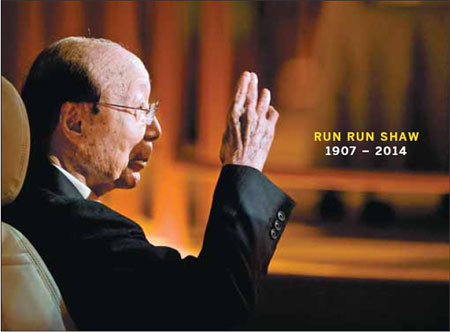Movie mogul Run Run Shaw, 107, dies in HK
By Raymond Zhou (China Daily) Updated: 2014-01-08 08:14In 1926, six major studios formed an alliance to boycott Tianyi. Distributors that wanted to show movies made by the six studios had to agree not to show anything from Tianyi. Partly to deflect the competitive pressures and partly to forestall the possible fires of war from the north, the Shaw brothers decided to explore the market in Southeast Asia, where there was a sizeable ethnic Chinese population. The 19-year-old Run Run and older brother Runme were sent to negotiate with cinema owners and companies.
The two brothers pleaded with exhibitors to show the prints they had brought with them. They rented a horse-drawn carriage and toured the rural areas. Their hard work paid off; soon they were buying up cinemas. The first few years in Southeast Asia, known as the South Seas in China, "gave me so much that was of benefit for the rest of my life", as Shaw later recalled. One of the explanations for his English name, Run Run, comes from that period, when the young man ran around endlessly in his attempts to start a business from ground up. A different explanation, which he endorsed, is the phonetic similarity of Run Run and Renleng, his real given name.
|
Movie and television producer Run Run Shaw attends the Shaw Prize presentation ceremony in Hong Kong on Sept 28, 2010. Shaw, 107, died on Tuesday. Wen Di / for China Daily |
Success allowed Tianyi to shift production to Hong Kong when Japanese bombs began to fall on Shanghai in 1932. Run Run's insistence on adopting sound technology - he made a perilous trip to San Francisco to purchase equipment - resulted in one of the first Cantonese-language films, The Platinum Dragon. The movie was a blockbuster and paved the road for the Shaws' expansion.
The backbone of their business was still in distribution and exhibition across Southeast Asia and by 1939, they owned 139 movie theaters in the region. Their movie empire was eventually crushed by the Japanese invasion of Asia.
Hong Kong legend
Run Run Shaw was aged 50 when he moved permanently from Southeast Asia to Hong Kong. Dissatisfied with his older brother's management style, the younger man bought him out, including the purchase of more than 74,320 square meters of land in Clearwater Bay.
In 1957, Run Run put his big dream to work. He launched Shaw Brothers Productions and broke ground in a seemingly remote suburb, constructing Movietown - a vertically integrated all-in-one facility that was clearly modeled on a Hollywood studio. The studio took seven years to come to completion, with 1,500 employees and four soundstages in the first phase. Everything required for movie making, other than the negatives, could be achieved on the premises.
As with Tianyi in Shanghai, the Shaw Brothers encountered fierce competition from other studios, especially Motion Pictures & General Investment Co, known as MP&GI.
- More female officials caught in corruption
- Whampoa veterans recorded with glory
- Police bust 9 terrorist groups in Xinjiang
- Knife-wielding attackers seized in Xinjiang
- New regulation leads to drop in petitioned cases
- Hunan plant shut as probe into lead poisoning begins
- Police boost efforts to combat gambling
- Project offers jobs openings to legal experts
- Experts: Dog meat festival 'illegal'
- Nation looks to upgrade
pipeline networks







